Forensic Magazine - Who Says You Can't Do That ... - the FDIAI
Forensic Magazine - Who Says You Can't Do That ... - the FDIAI
Forensic Magazine - Who Says You Can't Do That ... - the FDIAI
You also want an ePaper? Increase the reach of your titles
YUMPU automatically turns print PDFs into web optimized ePapers that Google loves.
<strong>Forensic</strong> <strong>Magazine</strong> - <strong>Who</strong> <strong>Says</strong> <strong>You</strong> <strong>Can't</strong> <strong>Do</strong> <strong>That</strong>? Knowledge: The Key To Crime Scene Investigation<br />
<strong>Who</strong> <strong>Says</strong> <strong>You</strong> <strong>Can't</strong> <strong>Do</strong> <strong>That</strong>? Knowledge: The Key To Crime Scene Investigation,<br />
Dick Warrington, February/March 2007<br />
Subscribe to receive more articles like this: Print/digital | Webfeed (RSS)<br />
The field of crime scene investigation is constantly changing. With advances in technology and science, we<br />
have more tools than ever to help us solve crimes. But in order to take advantage of <strong>the</strong>se tools, a crime scene<br />
officer needs to stay up-to-date with <strong>the</strong> latest developments and understand <strong>the</strong> capabilities of specialists in<br />
<strong>the</strong> field. <strong>You</strong>r goal is not to acquire <strong>the</strong> same level of knowledge as <strong>the</strong> expert, but to have enough knowledge<br />
of <strong>the</strong> field to recognize what <strong>the</strong> expert can accomplish with <strong>the</strong> right evidence. With this knowledge, you can<br />
tackle your crime scene in a systematic and thorough manner and provide <strong>the</strong> experts <strong>the</strong> evidence <strong>the</strong>y need.<br />
In this issue, I’ll give you an overview of some key areas you should focus on when processing a scene.<br />
To begin with, advances in fingerprint technology now allow experts to lift prints from surfaces that couldn’t be<br />
processed in <strong>the</strong> past. Ga<strong>the</strong>ring as much fingerprint evidence as possible is always important, so you should<br />
still begin by processing surfaces such as vehicles and windows right at <strong>the</strong> scene. But you should <strong>the</strong>n look<br />
for o<strong>the</strong>r potential sources of prints. For example, experts can lift latent prints from documents, papers, and<br />
adhesive tape. If <strong>the</strong>se items are present, carefully collect <strong>the</strong>m and send <strong>the</strong>m off to be processed by your<br />
local or state lab.<br />
DNA, of course, has become a crucial part of crime scene investigation. So much can be done with DNA, but if<br />
you don’t have knowledge of what <strong>the</strong> experts can do, you may miss <strong>the</strong> opportunity to identify a suspect.<br />
Besides looking for hair, blood, and cigarette butt evidence, you should also look for any material <strong>the</strong> suspect<br />
may have come into contact with. Take <strong>the</strong> time to swab surfaces such as <strong>the</strong> steering wheel of a vehicle or<br />
<strong>the</strong> grip of a gun. Also remember that if you are fingerprinting and develop smudges with no ridge detail, <strong>the</strong><br />
smudges can be swabbed for DNA testing. In <strong>the</strong> past, we couldn’t get DNA from <strong>the</strong>se sources, but now we<br />
can. In addition, you should also know that DNA can be retrieved from things like knit caps, baseball caps, and<br />
eye glasses. Collect all of <strong>the</strong>se items for <strong>the</strong> DNA experts and you’ll increase your chances of success.<br />
A good example of a crime scene that requires specialized knowledge is one involving a decomposed body.<br />
While a decomposing body presents many challenges, you can gain vital information if you know what<br />
evidence to collect and <strong>the</strong> right expert to contact. <strong>You</strong> can actually purchase an entomology kit that allows you<br />
to process <strong>the</strong> body right at <strong>the</strong> scene. By following <strong>the</strong> directions that come with <strong>the</strong> kit, you can collect <strong>the</strong><br />
maggots and o<strong>the</strong>r samples from <strong>the</strong> body. Once you have <strong>the</strong> necessary samples, you can send <strong>the</strong>m to an<br />
entomologist. Through an analysis of <strong>the</strong> samples, <strong>the</strong> entomologist can determine how long <strong>the</strong> body has<br />
been at <strong>the</strong> scene.<br />
Ano<strong>the</strong>r important type of evidence is blood spatter. A lot of information about homicides or o<strong>the</strong>r crimes can<br />
be gained by studying <strong>the</strong> pattern of blood on a surface. <strong>You</strong>r first step should be to document <strong>the</strong> evidence<br />
with photography and diagrams. Then, depending on <strong>the</strong> complexity of <strong>the</strong> evidence, you may also need to<br />
bring a blood spatter expert to <strong>the</strong> scene. Again, your goal is not to acquire <strong>the</strong> same level of knowledge as <strong>the</strong><br />
expert, but to have enough knowledge of <strong>the</strong> field to recognize what <strong>the</strong> expert can accomplish with <strong>the</strong> right<br />
evidence.<br />
Being knowledgeable about <strong>the</strong> study of bullet trajectory can prove to be useful for your case. If at least two<br />
points of contact exist, experts in this area with <strong>the</strong> proper equipment, can trace <strong>the</strong> path of a bullet and thus<br />
determine <strong>the</strong> exact position of <strong>the</strong> victim and <strong>the</strong> location of <strong>the</strong> shooter when <strong>the</strong> weapon was fired. Once<br />
you know <strong>the</strong> location or area of <strong>the</strong> shooter, you may discover fur<strong>the</strong>r evidence such as shell casings. All of<br />
this documentation can aid in preparing a strong case for court.<br />
Some of <strong>the</strong> most important experts you can work with when you are dealing with a homicide are from <strong>the</strong><br />
medical examiner’s office. Investigators can come to <strong>the</strong> scene to take <strong>the</strong>ir own photographs and notes to<br />
supplement yours. Once <strong>the</strong>y have <strong>the</strong> body at <strong>the</strong> morgue, <strong>the</strong>y can conduct a variety of tests and<br />
examinations that can provide crucial information.<br />
Making use of <strong>the</strong> expertise of a forensic pathologist can also be essential. While a hospital-based physician<br />
may be able to determine <strong>the</strong> time and cause of death, a forensic pathologist has <strong>the</strong> training and knowledge<br />
http://www.forensicmag.com/articles.asp?pid=135 (1 of 2)3/9/2007 10:06:02 PM
<strong>Forensic</strong> <strong>Magazine</strong> - <strong>Who</strong> <strong>Says</strong> <strong>You</strong> <strong>Can't</strong> <strong>Do</strong> <strong>That</strong>? Knowledge: The Key To Crime Scene Investigation<br />
to tell you even more about <strong>the</strong> crime itself. In a case in Topeka, KS, for example, <strong>the</strong> victim was found floating<br />
in a river, shot twice. However, <strong>the</strong> forensic pathologist was able to determine that <strong>the</strong> victim was shot twice<br />
with a double barreled gun — probably a Derringer — and that <strong>the</strong> victim had been beaten. The knowledge<br />
gained from such an expert can make or break your case. If you don’t have a forensic pathologist available in<br />
your town or city, you should get help from your state resources.<br />
Finally, you should also search for shoe and tire track information at <strong>the</strong> crime scene. If properly documented<br />
and collected, this evidence can aid in <strong>the</strong> prosecution of <strong>the</strong> case. The crime lab experts can compare <strong>the</strong><br />
evidence collected at <strong>the</strong> scene to <strong>the</strong> suspect’s items.<br />
The common denominator in any crime scene investigation is knowledge: you need to know both your own<br />
limits and <strong>the</strong> capabilities of <strong>the</strong> experts. Remember, your job is to build <strong>the</strong> strongest possible case. Once<br />
evidence is lost, you can’t go back and recreate it. And if you haven’t collected enough evidence or called in<br />
<strong>the</strong> right experts, you could end up with a case that won’t hold up in court. <strong>Do</strong>n’t stay in <strong>the</strong> Dark Ages. Take<br />
advantage of conferences sponsored by <strong>the</strong> International Association of Identification (IAI) and courses offered<br />
at many colleges and universities. These conferences and courses are an invaluable way to gain <strong>the</strong><br />
knowledge you need to do your job well.<br />
Dick Warrington is in research and development and a crime scene consultant and training instructor for <strong>the</strong><br />
Lynn Peavey Company. For <strong>the</strong> past several years, Dick has been teaching classes throughout <strong>the</strong> U.S. and<br />
Canada, trying to dispel some of those “you can’t do that” myths. Dick can be reached at<br />
dwarrington@peaveycorp.com<br />
Free <strong>Magazine</strong> Subscription | Article Index | Digital Issues | Ad Services<br />
Author Guidelines |Shows Conferences, and Events | Contact <strong>Forensic</strong> <strong>Magazine</strong><br />
| About Web Feeds| Home<br />
Copyright 2007 by Vicon Publishing, Inc. All Rights Reserved BPA Worldwide Membership Applied For | Terms of Use | Privacy Policy<br />
Design & Maintenance by S. La Palme Designs®<br />
http://www.forensicmag.com/articles.asp?pid=135 (2 of 2)3/9/2007 10:06:02 PM










